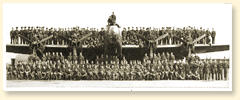

Personnel of 415 Squadron, RCAF, with one of the unit's Handley-Page Halifax
heavy bombers, East-Moor, Yorkshire, England 1944-1945 |
The Canadian Armed Forces: The Royal Canadian Air Force (RCAF)
The ran the
vital British Commonwealth Air Training Plan, but
it also sent nearly 94,000 personnel overseas, and played a major
role in the Battle of the Atlantic. More than half of its wartime
aircrew served in
,
but there were also 48
overseas; they made their most significant contributions in the
high-intensity operations over North-West Europe. Canadian bomber
formed no. 6 ,
Bomber Command, of the . Fighter
served in Canadian , especially in no. 83 ,
2nd Tactical
, for the Normandy invasion and the liberation
of Europe. No. 417 flew
fighters in North Africa and the
Mediterranean, while three bomber operated from North
Africa. Two transport and a
maritime patrol were
in the South East Asia . 51
served in North America,
although a number of these later went overseas. Many were part of
the antisubmarine campaign in the Atlantic, flying from bases on the
East Coast, in Newfoundland (not yet then a part of Canada) or
Iceland. Both fighter and maritime patrol flew in the
Aleutians campaign of 1942-1943. The wartime total enlistment of the was nearly 250,000 men
and women. It had had a meagre pre-war regular strength of 3,048,
with 270 aircraft of 23 types, nearly all of them already obsolete. Related Newspaper Articles
English Articles
French Articles
-
Nos aviateurs outre-mer
Le Devoir, 08/03/1940
-
Le recrutement des aviateurs dans la province de Québec
Le Devoir, 15/08/1940
-
La bataille de la Grande-Bretagne - L'escadrille canadienne
Le Devoir, 16/09/1940
-
Nos aviateurs en territoire ennemi
Le Devoir, 11/12/1940
-
Le Corps d'Aviation Royal Canadien
Le Devoir, 24/12/1940
-
40 escadrilles canadiennes
Le Devoir, 24/01/1941
-
Le Corps d'Aviation Royal Canadien
Le Devoir, 09/04/1941
-
Ceux qui écrivent nos pages d'histoire
Le Devoir, 13/05/1941
-
M. Power veut canadianiser notre aviation outre-mer
Le Devoir, 29/07/1941
-
La puissance et le rôle de l'aviation canadienne
Le Devoir, 20/08/1941
-
Une escadrille canadienne-française
Le Devoir, 03/11/1941
-
Patrouille intense au-dessus de la côte du Pacifique
Le Devoir, 10/12/1941
-
Les cadres ne sont jamais plein
Le Devoir, 23/02/1942
-
Pilotes canadiens-français
Le Devoir, 06/04/1942
-
Les Canadiennes au service de l'aviation
Le Devoir, 13/08/1942
-
Naissance du premier corps de bombardiers canadien
Le Devoir, 04/01/1943
-
Premier contingent de bombardiers arrivé en Angleterre
Le Devoir, 08/02/1943
-
La vie des aviateurs en Angleterre
Le Devoir, 16/08/1944
-
Nos aviateurs canadiens outre-mer
Le Devoir, 15/12/1944
-
Les bombardiers-lourds canadiens cessent d'opérer
Le Devoir, 04/05/1945
|